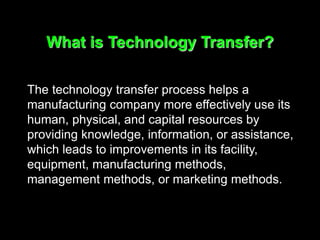Technology transfer involves the sharing of knowledge, information, or assistance between organizations to help improve processes, equipment, methods, or marketing. It includes the progression from invention to innovation to design and finally diffusion or marketing of new technologies. There are many factors that influence how long it takes an invention to reach the market, including the need for further innovation, design improvements, feedback from potential users, and promotion of the new technology. Effective technology transfer relies on the flow of various types of information between parties.












































































